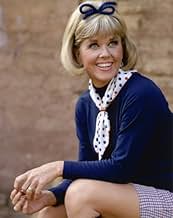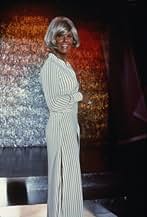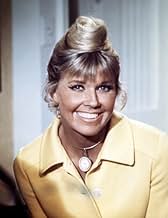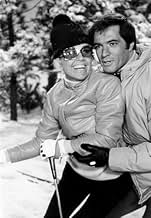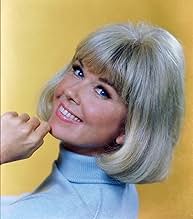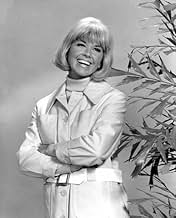IMDb RATING
7.2/10
949
YOUR RATING
After spending most of her life in big cities, widow Doris Martin decides to move back to the family ranch.After spending most of her life in big cities, widow Doris Martin decides to move back to the family ranch.After spending most of her life in big cities, widow Doris Martin decides to move back to the family ranch.
- Awards
- 2 nominations total
Browse episodes
Featured reviews
When I was a kid this was my first exposure to Doris Day. I was only two when this show first aired and I used to watch it every week. However, it was fairly confusing due to the fact that it changed situations almost every season. In the first season she was the typical widowed mom raising her two kids in an almost carbon copy of "Green Acres", but without the surrealism of that show. In the second season we see her become a writer for a magazine, which she would remain, with slight variations for the next few years. However, in the final season, the show pretty much becomes another version of "Mary Tyler Moore" with her now playing a single girl and without the kids that she had for the first few years. However, despite these changes Doris Day retained the charm and grace that made her one of the most popular stars in television.
Also, one thing that is quite ironic is the fact that this show was set in San Francisco, which was the same locale as her former co-star, and close friend, Rock Hudson's series "McMillan and Wife". That fact could have led to all sorts of guest star possibilities.
Also, one thing that is quite ironic is the fact that this show was set in San Francisco, which was the same locale as her former co-star, and close friend, Rock Hudson's series "McMillan and Wife". That fact could have led to all sorts of guest star possibilities.
"Raysond" wrote this in his/her review: "due to low ratings and a sorry time slot) to let it go and from there "The Doris Day Show" was canceled by CBS. Also during this time the career of singer/actress/producer Doris Day was over and to this day in 1973 officially retired from the entertainment industry where she is living peacefully somewhere in her private estate in Hollywood."
Nothing could be far from the truth. Yes, CBS dealt Doris Day a "Ft. Knox Hand" (that's what VARIETY called it) to Miss Day for her to do a TV series. But, unlike what was reported by Raysond, the series was consistently in the Top 20 it's entire run. Doris Day called it quits with CBS. She had never wanted to do television in the first place: her husband secretly signed her to the CBS contract without her permission. He died, and as Day has said, "I was delivered to CBS." From what I have read, CBS wanted Doris to re-sign and continue the show, but she declined. She did, however, live up to her contract and did the two musical specials that her late husband promised.
Most people are not aware, but Doris' film career was far from over in 1968. Her three films that year ("Ballad of Josie," "Where Were You When The Lights Went Out" and "With Six You Get Eggroll") should have landed her among the top ten box office stars, but with the news that she would be doing a TV show, Quigley's Poll didn't bother. The fact is, Doris Day's 1968 films out-grossed several of the stars who made the list.
Nothing could be far from the truth. Yes, CBS dealt Doris Day a "Ft. Knox Hand" (that's what VARIETY called it) to Miss Day for her to do a TV series. But, unlike what was reported by Raysond, the series was consistently in the Top 20 it's entire run. Doris Day called it quits with CBS. She had never wanted to do television in the first place: her husband secretly signed her to the CBS contract without her permission. He died, and as Day has said, "I was delivered to CBS." From what I have read, CBS wanted Doris to re-sign and continue the show, but she declined. She did, however, live up to her contract and did the two musical specials that her late husband promised.
Most people are not aware, but Doris' film career was far from over in 1968. Her three films that year ("Ballad of Josie," "Where Were You When The Lights Went Out" and "With Six You Get Eggroll") should have landed her among the top ten box office stars, but with the news that she would be doing a TV show, Quigley's Poll didn't bother. The fact is, Doris Day's 1968 films out-grossed several of the stars who made the list.
THE DORIS DAY SHOW (CBS, 1968-73), stars Doris Day in her only weekly comedy series. An actress whose screen career lasted twenty years (1948-1968), ranging from musicals, comedies and heavy dramas, at this point. By 1968, her career was virtually over, until finding herself working for the little screen called television.
THE DORIS DAY SHOW, premiering on CBS in September of 1968, opens with her signature theme song, "Que Sera Sera." The first season finds the widowed Doris Martin (Doris Day), living with her white haired, bearded father, Buck Webb (Denver Pyle) on the family ranch with her two blond-haired sons, Billy (Philip Brown) and Toby (Todd Starke), the little guy with a buck tooth. With similarities to the recent TV show, GREEN ACRES, Doris is a city girl now back on the farm. Supporting her father is the hired hand country boy, LeRoy B. Simpson (James Hampton). There's also a housekeeper, Aggie (Fran Ryan), and later Juanita (Naomi Stevens). The first season followed the tradition of other sit-coms of that time, sugar sweetness with country humor, never rising above the number one TV show of that time, THE ANDY GRIFFITH SHOW. The second season found Doris Martin still living on the farm, but now commuting to San Francisco and working as a secretary for Mr. Nicholson (MacLean Stevenson) at TODAY'S WORLD MAGAZINE. Also in support is Myrna Gibbons (Rose Marie, best known as Sally Rogers in THE DICK VAN DYKE SHOW). Rose Marie became an added plus in the show, although her character, a single woman always looking for the Mr. Right, was actually no different from her role on Van Dyke's show. Myrna and Doris were given a second banana character in the carnation of Ron Harvey (Paul Smith), a bachelor co-worker on the trail of beautiful female companionship. With this change, the show was slowly finding itself. For season three, Doris moves from her father's farm, taking her the boys and their sheepdog, Lord Nelson, to an apartment in San Francisco over an Italian restaurant run by Angie and Louie Palucci (Kaye Ballard and Bernie Kopell). Doris continues to work at TODAY'S WORLD MAGAZINE. Denver Pyle, no longer a series regular, appeared occasionally mostly in guest spots. While still working woman, Doris manages to find quality time with her boys. Up to this time, THE DORIS DAY SHOW improved, showing both humor and heart to the character and plots, but it was still trying to find itself.
As a youngster growing up during this period, I always enjoyed programs like this, especially whenever they included kids. The big change came with seasons four and five when Mrs. Doris Martin, still working at TODAY'S WORLD MAGAZINE and living in the same apartment on top of Palucci's Italian Restaurant, becomes Miss Doris Martin, a bachelor girl. The format shifted gears, eliminating the Martin boys, their dog, and contradicting everything from the previous seasons. Regardless, the show finally found itself. Of course there were occasional characters reprising their roles from the previous seasons, namely Kaye Ballard, Van Johnson and Billy DeWolfe (hilarious as Mr. Jarvis), so obviously this is the same character and same show with different format. Another difference, being true to life, is Doris now working as a staff writer for a new boss, Cy Bennett (the mustached John Dehner), supported by new co-worker pal, Jackie (Jackie Joseph). Changing her employer from a handsome and easy-going man to a stuffy middle-aged miser was a fine change, which found Doris at wits with her stingy boss. The final two seasons is the format that lasted the longest.
This new format would have worked had Doris Martin remained what she has been previously. Having the boys mentioned as being sent away to boarding school would have explained the emptiness of her apartment. It's surprising it wasn't renamed THE NEW DORIS DAY SHOW. What did happen was Doris Day succeeded in making this dramatic change work. For most, the working girl/family episodes from the second and third seasons are the best. The worst episodes are those with Doris as the only model in the annual fashion shows. A musical show showcasing Doris's fine singing voice would have been preferable, almost as nostalgic as the two Christmas episodes (1970 and 1971) which made them so enjoyable. One episode I remember most but like the least is "Young Love" from Season Three, where Doris appears in the opening segment, comforting a troubled teen named April (played by Meredith Baxter), who tells her story via flashback, taking up the entire episode. In Seasons Four and Five, Doris Martin found a romantic love interest, a middle-aged doctor, played by silver-haired Peter Lawford.
An episode, which I feel might be the one closest to Doris Day's heart, is the one in which she goes on trial for releasing a group of dogs locked in an automobile parked in the hot sun with shut windows. After being taken to court by the owner, she, of course, gets acquitted following her plea in the courtroom for the safety of dogs and other creatures, and her willingness to do what she did again even if it meant serving jail time. No doubt this could be Doris Day's personal favorite since it's more Doris Martin being Doris Day, an animal rights activist.
All episodes of THE DORIS DAY SHOW were produced on film and in color. Interestingly, seldom revived in syndication. Unseen on cable since the 1980s, all 128 episodes are currently available on DVD.
THE DORIS DAY SHOW, premiering on CBS in September of 1968, opens with her signature theme song, "Que Sera Sera." The first season finds the widowed Doris Martin (Doris Day), living with her white haired, bearded father, Buck Webb (Denver Pyle) on the family ranch with her two blond-haired sons, Billy (Philip Brown) and Toby (Todd Starke), the little guy with a buck tooth. With similarities to the recent TV show, GREEN ACRES, Doris is a city girl now back on the farm. Supporting her father is the hired hand country boy, LeRoy B. Simpson (James Hampton). There's also a housekeeper, Aggie (Fran Ryan), and later Juanita (Naomi Stevens). The first season followed the tradition of other sit-coms of that time, sugar sweetness with country humor, never rising above the number one TV show of that time, THE ANDY GRIFFITH SHOW. The second season found Doris Martin still living on the farm, but now commuting to San Francisco and working as a secretary for Mr. Nicholson (MacLean Stevenson) at TODAY'S WORLD MAGAZINE. Also in support is Myrna Gibbons (Rose Marie, best known as Sally Rogers in THE DICK VAN DYKE SHOW). Rose Marie became an added plus in the show, although her character, a single woman always looking for the Mr. Right, was actually no different from her role on Van Dyke's show. Myrna and Doris were given a second banana character in the carnation of Ron Harvey (Paul Smith), a bachelor co-worker on the trail of beautiful female companionship. With this change, the show was slowly finding itself. For season three, Doris moves from her father's farm, taking her the boys and their sheepdog, Lord Nelson, to an apartment in San Francisco over an Italian restaurant run by Angie and Louie Palucci (Kaye Ballard and Bernie Kopell). Doris continues to work at TODAY'S WORLD MAGAZINE. Denver Pyle, no longer a series regular, appeared occasionally mostly in guest spots. While still working woman, Doris manages to find quality time with her boys. Up to this time, THE DORIS DAY SHOW improved, showing both humor and heart to the character and plots, but it was still trying to find itself.
As a youngster growing up during this period, I always enjoyed programs like this, especially whenever they included kids. The big change came with seasons four and five when Mrs. Doris Martin, still working at TODAY'S WORLD MAGAZINE and living in the same apartment on top of Palucci's Italian Restaurant, becomes Miss Doris Martin, a bachelor girl. The format shifted gears, eliminating the Martin boys, their dog, and contradicting everything from the previous seasons. Regardless, the show finally found itself. Of course there were occasional characters reprising their roles from the previous seasons, namely Kaye Ballard, Van Johnson and Billy DeWolfe (hilarious as Mr. Jarvis), so obviously this is the same character and same show with different format. Another difference, being true to life, is Doris now working as a staff writer for a new boss, Cy Bennett (the mustached John Dehner), supported by new co-worker pal, Jackie (Jackie Joseph). Changing her employer from a handsome and easy-going man to a stuffy middle-aged miser was a fine change, which found Doris at wits with her stingy boss. The final two seasons is the format that lasted the longest.
This new format would have worked had Doris Martin remained what she has been previously. Having the boys mentioned as being sent away to boarding school would have explained the emptiness of her apartment. It's surprising it wasn't renamed THE NEW DORIS DAY SHOW. What did happen was Doris Day succeeded in making this dramatic change work. For most, the working girl/family episodes from the second and third seasons are the best. The worst episodes are those with Doris as the only model in the annual fashion shows. A musical show showcasing Doris's fine singing voice would have been preferable, almost as nostalgic as the two Christmas episodes (1970 and 1971) which made them so enjoyable. One episode I remember most but like the least is "Young Love" from Season Three, where Doris appears in the opening segment, comforting a troubled teen named April (played by Meredith Baxter), who tells her story via flashback, taking up the entire episode. In Seasons Four and Five, Doris Martin found a romantic love interest, a middle-aged doctor, played by silver-haired Peter Lawford.
An episode, which I feel might be the one closest to Doris Day's heart, is the one in which she goes on trial for releasing a group of dogs locked in an automobile parked in the hot sun with shut windows. After being taken to court by the owner, she, of course, gets acquitted following her plea in the courtroom for the safety of dogs and other creatures, and her willingness to do what she did again even if it meant serving jail time. No doubt this could be Doris Day's personal favorite since it's more Doris Martin being Doris Day, an animal rights activist.
All episodes of THE DORIS DAY SHOW were produced on film and in color. Interestingly, seldom revived in syndication. Unseen on cable since the 1980s, all 128 episodes are currently available on DVD.
This show ran from 1968 until 1973, and I hadn't seen it on TV probably since its initial run until the DVDs came out. The show aired at a time when American culture was going through a great transition. When Doris Day first went on the air Bonanza and The Andy Griffith Show were the top television draws. By the time it went off the air it was All in the Family and M.A.S.H. Thus it is amazing that Doris Day stayed on the air for five years during this time when her clean-cut image probably set her apart from the crowd, and then walked away from her show - the show was not canceled due to poor ratings. In fact, it did quite well throughout its run.
It will take you back to a simpler time, but then so did Doris Day's films and I still find those enjoyable. The show did make major changes to accommodate the changing times. Initially it had a rural setting with Doris being a widow with two sons who played a major part in the show. First the show had her moving to San Francisco. Next she and her sons moved to a more "hip" apartment. By season four the kids and her widowhood status had disappeared and she was single. Her father and her sons just vanished into thin air, never to be mentioned again.
Also, Doris evolved from a secretary to an associate editor. However, she kept her name and the second apartment she had when her sons had existed. It was very confusing. I'd still recommend it, just remember that culture changed so fast in the U.S. during this time that it even had an effect on how Doris Day was presented.
It will take you back to a simpler time, but then so did Doris Day's films and I still find those enjoyable. The show did make major changes to accommodate the changing times. Initially it had a rural setting with Doris being a widow with two sons who played a major part in the show. First the show had her moving to San Francisco. Next she and her sons moved to a more "hip" apartment. By season four the kids and her widowhood status had disappeared and she was single. Her father and her sons just vanished into thin air, never to be mentioned again.
Also, Doris evolved from a secretary to an associate editor. However, she kept her name and the second apartment she had when her sons had existed. It was very confusing. I'd still recommend it, just remember that culture changed so fast in the U.S. during this time that it even had an effect on how Doris Day was presented.
How this show lasted five years is amazing considering each year the show was about something else. Her trademark theme song said it each week: 'What ever will be will be!' The show aired between 1968 and 1973, a time when women's roles changed in society and on television. "The Doris Day Show" reflected these changes beginning with Doris as a "modern housewife:" a widowed mother of two living in the country, and evolved into a pre-Mary Richards role model for single women in the work place (the first ever on television!) Because each year brought a different look (and different cast) to the show, it is difficult to sell in syndication but perhaps Nick-at-Night which prides itself in the evolution of such shows will have fun with it some day. (My suggestion: Do one of those five nights a week summers where Monday has the first year, Tuesday has the second year, and so forth...each year really was an entity unto itself.) The bottom line is that it features America's sweetheart Doris Day and that's really all that it needed. What ever will be will be.
Did you know
- TriviaDoris Day's contract with CBS to do this series set a record, with her production company getting several million dollars in up-front money. It was negotiated by Martin Melcher, her husband of 17 years. However, after Melcher died unexpectedly in April of 1968, just five months before the series was to debut, Day said she had no knowledge of ever having signed on to do the show. It turned out that Melcher and the couple's lawyer and financial advisor had squandered the millions of dollars that Day had made in her 20-year career in films and records, leaving her not only flat broke but also more than $500,000 in debt. Melcher, desperate for money, had used his position as her husband and manager and had contracted with CBS to produce a sitcom for Day, but he never told her about it.
- ConnectionsFeatured in Biography: Doris Day: It's Magic (1998)
- How many seasons does The Doris Day Show have?Powered by Alexa
Details
- Release date
- Country of origin
- Language
- Also known as
- El show de Doris Day
- Filming locations
- 650 California Street, San Francisco, California, USA(Today's World magazine office)
- Production company
- See more company credits at IMDbPro
Contribute to this page
Suggest an edit or add missing content

